Bin Li
Member, IEEE
Accelerating Data Generation for Nonlinear temporal PDEs via homologous perturbation in solution space
Oct 24, 2025Abstract:Data-driven deep learning methods like neural operators have advanced in solving nonlinear temporal partial differential equations (PDEs). However, these methods require large quantities of solution pairs\u2014the solution functions and right-hand sides (RHS) of the equations. These pairs are typically generated via traditional numerical methods, which need thousands of time steps iterations far more than the dozens required for training, creating heavy computational and temporal overheads. To address these challenges, we propose a novel data generation algorithm, called HOmologous Perturbation in Solution Space (HOPSS), which directly generates training datasets with fewer time steps rather than following the traditional approach of generating large time steps datasets. This algorithm simultaneously accelerates dataset generation and preserves the approximate precision required for model training. Specifically, we first obtain a set of base solution functions from a reliable solver, usually with thousands of time steps, and then align them in time steps with training datasets by downsampling. Subsequently, we propose a "homologous perturbation" approach: by combining two solution functions (one as the primary function, the other as a homologous perturbation term scaled by a small scalar) with random noise, we efficiently generate comparable-precision PDE data points. Finally, using these data points, we compute the variation in the original equation's RHS to form new solution pairs. Theoretical and experimental results show HOPSS lowers time complexity. For example, on the Navier-Stokes equation, it generates 10,000 samples in approximately 10% of traditional methods' time, with comparable model training performance.
KORE: Enhancing Knowledge Injection for Large Multimodal Models via Knowledge-Oriented Augmentations and Constraints
Oct 22, 2025Abstract:Large Multimodal Models encode extensive factual knowledge in their pre-trained weights. However, its knowledge remains static and limited, unable to keep pace with real-world developments, which hinders continuous knowledge acquisition. Effective knowledge injection thus becomes critical, involving two goals: knowledge adaptation (injecting new knowledge) and knowledge retention (preserving old knowledge). Existing methods often struggle to learn new knowledge and suffer from catastrophic forgetting. To address this, we propose KORE, a synergistic method of KnOwledge-oRientEd augmentations and constraints for injecting new knowledge into large multimodal models while preserving old knowledge. Unlike general text or image data augmentation, KORE automatically converts individual knowledge items into structured and comprehensive knowledge to ensure that the model accurately learns new knowledge, enabling accurate adaptation. Meanwhile, KORE stores previous knowledge in the covariance matrix of LMM's linear layer activations and initializes the adapter by projecting the original weights into the matrix's null space, defining a fine-tuning direction that minimizes interference with previous knowledge, enabling powerful retention. Extensive experiments on various LMMs, including LLaVA-v1.5-7B, LLaVA-v1.5-13B, and Qwen2.5-VL-7B, show that KORE achieves superior new knowledge injection performance and effectively mitigates catastrophic forgetting.
UniMIC: Token-Based Multimodal Interactive Coding for Human-AI Collaboration
Sep 26, 2025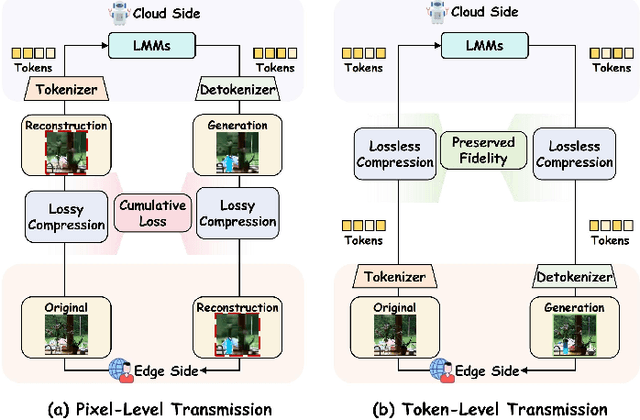
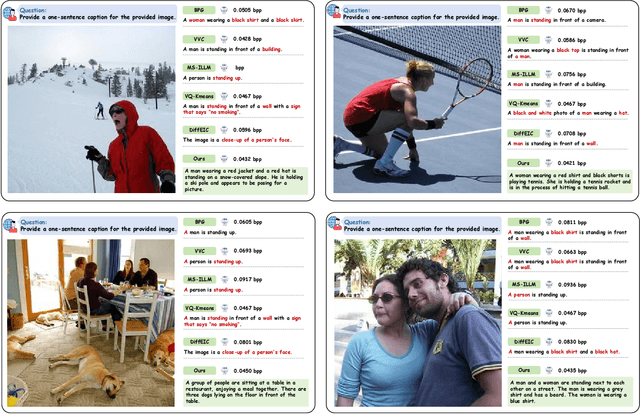
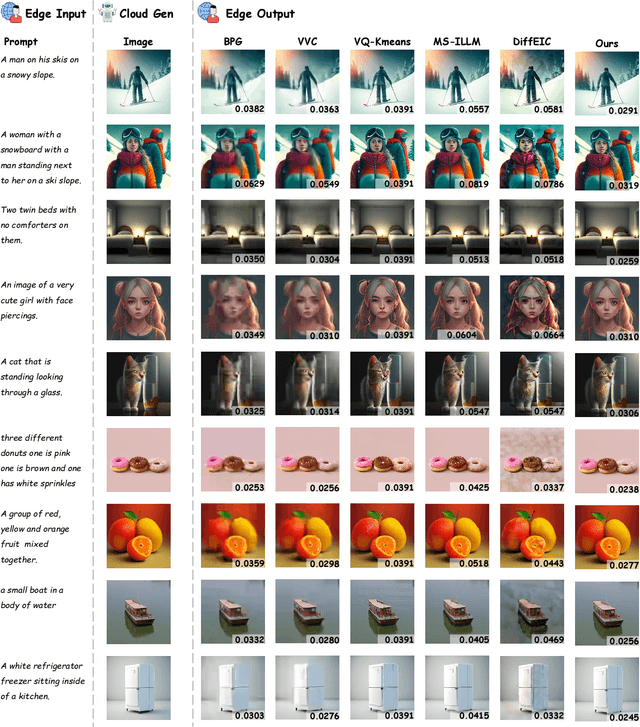
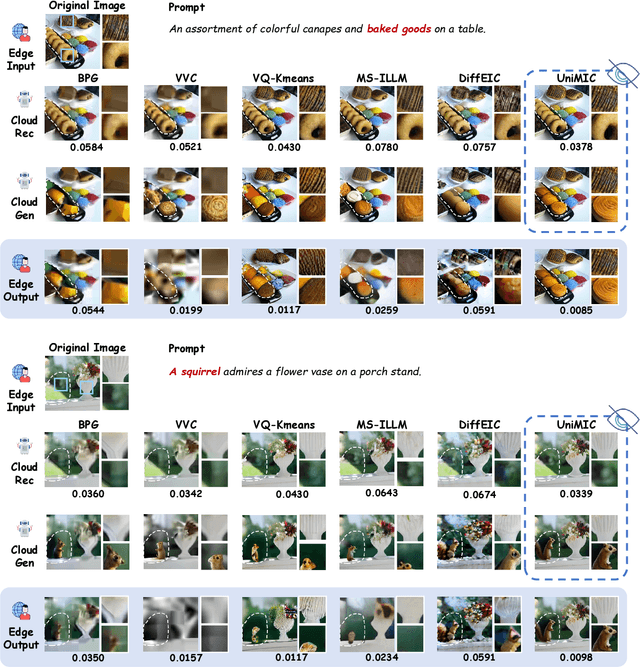
Abstract:The rapid progress of Large Multimodal Models (LMMs) and cloud-based AI agents is transforming human-AI collaboration into bidirectional, multimodal interaction. However, existing codecs remain optimized for unimodal, one-way communication, resulting in repeated degradation under conventional compress-transmit-reconstruct pipelines. To address this limitation, we propose UniMIC, a Unified token-based Multimodal Interactive Coding framework that bridges edge devices and cloud AI agents. Instead of transmitting raw pixels or plain text, UniMIC employs compact tokenized representations as the communication medium, enabling efficient low-bitrate transmission while maintaining compatibility with LMMs. To further enhance compression, lightweight Transformer-based entropy models with scenario-specific designs-generic, masked, and text-conditioned-effectively minimize inter-token redundancy. Extensive experiments on text-to-image generation, text-guided inpainting, outpainting, and visual question answering show that UniMIC achieves substantial bitrate savings and remains robust even at ultra-low bitrates (<0.05bpp), without compromising downstream task performance. These results establish UniMIC as a practical and forward-looking paradigm for next-generation multimodal interactive communication.
Training-Free Pyramid Token Pruning for Efficient Large Vision-Language Models via Region, Token, and Instruction-Guided Importance
Sep 19, 2025Abstract:Large Vision-Language Models (LVLMs) have significantly advanced multimodal understanding but still struggle with efficiently processing high-resolution images. Recent approaches partition high-resolution images into multiple sub-images, dramatically increasing the number of visual tokens and causing exponential computational overhead during inference. To address these limitations, we propose a training-free token pruning strategy, Pyramid Token Pruning (PTP), that integrates bottom-up visual saliency at both region and token levels with top-down instruction-guided importance. Inspired by human visual attention mechanisms, PTP selectively retains more tokens from visually salient regions and further leverages textual instructions to pinpoint tokens most relevant to specific multimodal tasks. Extensive experiments across 13 diverse benchmarks demonstrate that our method substantially reduces computational overhead and inference latency with minimal performance loss.
MedFact-R1: Towards Factual Medical Reasoning via Pseudo-Label Augmentation
Sep 18, 2025

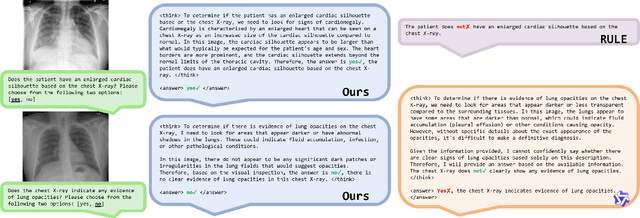
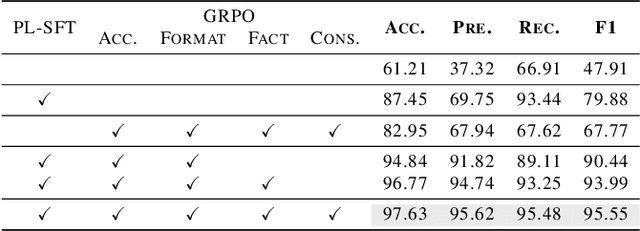
Abstract:Ensuring factual consistency and reliable reasoning remains a critical challenge for medical vision-language models. We introduce MEDFACT-R1, a two-stage framework that integrates external knowledge grounding with reinforcement learning to improve the factual medical reasoning. The first stage uses pseudo-label supervised fine-tuning (SFT) to incorporate external factual expertise; while the second stage applies Group Relative Policy Optimization (GRPO) with four tailored factual reward signals to encourage self-consistent reasoning. Across three public medical QA benchmarks, MEDFACT-R1 delivers up to 22.5% absolute improvement in factual accuracy over previous state-of-the-art methods. Ablation studies highlight the necessity of pseudo-label SFT cold start and validate the contribution of each GRPO reward, underscoring the synergy between knowledge grounding and RL-driven reasoning for trustworthy medical AI. Codes are released at https://github.com/Garfieldgengliang/MEDFACT-R1.
HERO: Rethinking Visual Token Early Dropping in High-Resolution Large Vision-Language Models
Sep 16, 2025Abstract:By cropping high-resolution images into local tiles and encoding them independently, High-Resolution Large Vision-Language Models (HR-LVLMs) have demonstrated remarkable fine-grained visual understanding capabilities. However, this divide-and-conquer paradigm significantly increases the number of visual tokens, resulting in substantial computational and memory overhead. To better understand and address this challenge, we empirically investigate visual token utilization in HR-LVLMs and uncover three key findings: (1) the local tiles have varying importance, jointly determined by visual saliency and task relevance; (2) the CLS token in CLIP-based vision encoders exhibits a two-stage attention pattern across layers, with each stage attending to different types of visual tokens; (3) the visual tokens emphasized at different stages encode information at varying levels of granularity, playing complementary roles within LVLMs. Building on these insights, we propose HERO, a High-resolution visual token early dropping framework that integrates content-adaptive token budget allocation with function-aware token selection. By accurately estimating tile-level importance and selectively retaining visual tokens with complementary roles, HERO achieves superior efficiency-accuracy trade-offs across diverse benchmarks and model scales, all in a training-free manner. This study provides both empirical insights and practical solutions toward efficient inference in HR-LVLMs.
Brought a Gun to a Knife Fight: Modern VFM Baselines Outgun Specialized Detectors on In-the-Wild AI Image Detection
Sep 16, 2025



Abstract:While specialized detectors for AI-generated images excel on curated benchmarks, they fail catastrophically in real-world scenarios, as evidenced by their critically high false-negative rates on `in-the-wild' benchmarks. Instead of crafting another specialized `knife' for this problem, we bring a `gun' to the fight: a simple linear classifier on a modern Vision Foundation Model (VFM). Trained on identical data, this baseline decisively `outguns' bespoke detectors, boosting in-the-wild accuracy by a striking margin of over 20\%. Our analysis pinpoints the source of the VFM's `firepower': First, by probing text-image similarities, we find that recent VLMs (e.g., Perception Encoder, Meta CLIP2) have learned to align synthetic images with forgery-related concepts (e.g., `AI-generated'), unlike previous versions. Second, we speculate that this is due to data exposure, as both this alignment and overall accuracy plummet on a novel dataset scraped after the VFM's pre-training cut-off date, ensuring it was unseen during pre-training. Our findings yield two critical conclusions: 1) For the real-world `gunfight' of AI-generated image detection, the raw `firepower' of an updated VFM is far more effective than the `craftsmanship' of a static detector. 2) True generalization evaluation requires test data to be independent of the model's entire training history, including pre-training.
On the Regularity and Fairness of Combinatorial Multi-Armed Bandit
Sep 15, 2025Abstract:The combinatorial multi-armed bandit model is designed to maximize cumulative rewards in the presence of uncertainty by activating a subset of arms in each round. This paper is inspired by two critical applications in wireless networks, where it's not only essential to maximize cumulative rewards but also to guarantee fairness among arms (i.e., the minimum average reward required by each arm) and ensure reward regularity (i.e., how often each arm receives the reward). In this paper, we propose a parameterized regular and fair learning algorithm to achieve these three objectives. In particular, the proposed algorithm linearly combines virtual queue-lengths (tracking the fairness violations), Time-Since-Last-Reward (TSLR) metrics, and Upper Confidence Bound (UCB) estimates in its weight measure. Here, TSLR is similar to age-of-information and measures the elapsed number of rounds since the last time an arm received a reward, capturing the reward regularity performance, and UCB estimates are utilized to balance the tradeoff between exploration and exploitation in online learning. By exploring a key relationship between virtual queue-lengths and TSLR metrics and utilizing several non-trivial Lyapunov functions, we analytically characterize zero cumulative fairness violation, reward regularity, and cumulative regret performance under our proposed algorithm. These theoretical outcomes are verified by simulations based on two real-world datasets.
Webly-Supervised Image Manipulation Localization via Category-Aware Auto-Annotation
Aug 28, 2025Abstract:Images manipulated using image editing tools can mislead viewers and pose significant risks to social security. However, accurately localizing the manipulated regions within an image remains a challenging problem. One of the main barriers in this area is the high cost of data acquisition and the severe lack of high-quality annotated datasets. To address this challenge, we introduce novel methods that mitigate data scarcity by leveraging readily available web data. We utilize a large collection of manually forged images from the web, as well as automatically generated annotations derived from a simpler auxiliary task, constrained image manipulation localization. Specifically, we introduce a new paradigm CAAAv2, which automatically and accurately annotates manipulated regions at the pixel level. To further improve annotation quality, we propose a novel metric, QES, which filters out unreliable annotations. Through CAAA v2 and QES, we construct MIMLv2, a large-scale, diverse, and high-quality dataset containing 246,212 manually forged images with pixel-level mask annotations. This is over 120x larger than existing handcrafted datasets like IMD20. Additionally, we introduce Object Jitter, a technique that further enhances model training by generating high-quality manipulation artifacts. Building on these advances, we develop a new model, Web-IML, designed to effectively leverage web-scale supervision for the image manipulation localization task. Extensive experiments demonstrate that our approach substantially alleviates the data scarcity problem and significantly improves the performance of various models on multiple real-world forgery benchmarks. With the proposed web supervision, Web-IML achieves a striking performance gain of 31% and surpasses previous SOTA TruFor by 24.1 average IoU points. The dataset and code will be made publicly available at https://github.com/qcf-568/MIML.
From Intent to Execution: Multimodal Chain-of-Thought Reinforcement Learning for Precise CAD Code Generation
Aug 13, 2025Abstract:Computer-Aided Design (CAD) plays a vital role in engineering and manufacturing, yet current CAD workflows require extensive domain expertise and manual modeling effort. Recent advances in large language models (LLMs) have made it possible to generate code from natural language, opening new opportunities for automating parametric 3D modeling. However, directly translating human design intent into executable CAD code remains highly challenging, due to the need for logical reasoning, syntactic correctness, and numerical precision. In this work, we propose CAD-RL, a multimodal Chain-of-Thought (CoT) guided reinforcement learning post training framework for CAD modeling code generation. Our method combines CoT-based Cold Start with goal-driven reinforcement learning post training using three task-specific rewards: executability reward, geometric accuracy reward, and external evaluation reward. To ensure stable policy learning under sparse and high-variance reward conditions, we introduce three targeted optimization strategies: Trust Region Stretch for improved exploration, Precision Token Loss for enhanced dimensions parameter accuracy, and Overlong Filtering to reduce noisy supervision. To support training and benchmarking, we release ExeCAD, a noval dataset comprising 16,540 real-world CAD examples with paired natural language and structured design language descriptions, executable CADQuery scripts, and rendered 3D models. Experiments demonstrate that CAD-RL achieves significant improvements in reasoning quality, output precision, and code executability over existing VLMs.
 Add to Chrome
Add to Chrome Add to Firefox
Add to Firefox Add to Edge
Add to Edge